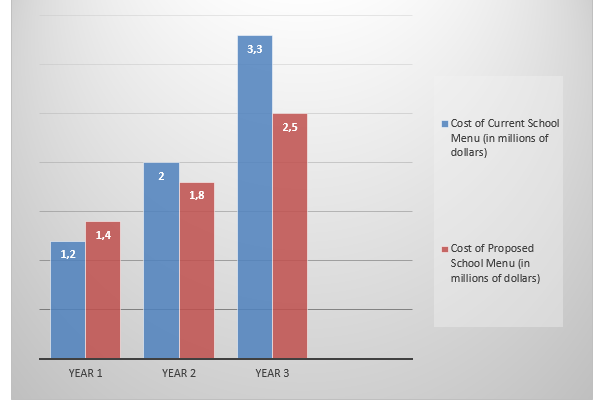As a means of solving the previously discussed problem of childhood obesity, the author of the research proposes to develop custom healthy menus for schools under a program called “Soul Food.” This solution will work better than others because the menu will be based on the preferences of the children’s parents. This fact distinguishes Soul Food from other solutions in that it will eventually help the government and parents join forces in tackling such a challenging issue. The solution will ultimately be successful because it embraces parental love, healthy food, and effective administrative policies.
To address the problem of childhood obesity properly, it is essential to examine its roots as well as to identify specific ways to effectively create positive change. Because the problem of childhood obesity is so complex, both families and school staff should be involved in resolving it. Soul Food is the best solution because it offers an innovative approach to a relatively new problem. The secret behind it lies in the fact that parents will be involved in the project as the main actors, along with the willing cooperation of school administration.
The uniqueness of such an approach sets this solution apart from most of the other equally good solutions. The aspect that is missing from other solutions is an understanding of how to make children eat healthily without imposing it on them at the same time. It is a known psychological fact that children are more likely to eat healthy food if it is presented in the form of a cheeseburger or some other popular type of junk food. Some people think that the solution to childhood obesity lies in using tort law to sue McDonald’s, Coca-Cola, and other corporations, but suing a company is not going to solve the essential causes of the problem (Sugarman & Sandman, 2007).
Although the Soul Food solution is still untested, researchers will be able to collect data carefully, process it, and reach a verdict that is reasonable and factual. This solution has a greater chance for success because it combines not only the parents’ opinion on the school menu but also the school administration’s approval. This solution is unique and represents an idea of how schools can serve smaller portions of healthier food that looks like junk food—effectively tricking children into eating healthier food because they love the unhealthy food it mimics (Singh & Davidson, 2015).
To successfully implement this solution, the initial step that must be taken is the written approval of the school where the project will take place. The second step is the writing, elaboration, and ratification of the menu itself. The solution will be implemented by the school’s administration under the guidance of a food-processing expert, a professional nutritionist, and a qualified pediatrician.
When the solution is implemented, all kinds of possible positive and negative outcomes are expected so that the program could be adapted to the current situation on the fly.
The investment required to implement Soul Food is worthwhile because children are the future of our country, and childhood obesity is a significant problem that affects not only their physical health but their mental state as well (Söderback, 2015). The essential resource the research relies on is money. In this section of your draft, you will expand on these ideas, specifically organizing your paper according to the aspects detailed below.
The plan is worthwhile in terms of time, energy, and money, and it will ultimately result in a reduced number of children with heart disease and other health problems that arise as a result of consuming junk food. Soul Food’s fight against obesity will start on a local scale, but if the strategy turns out to be effective, it should be applied to all the schools within the state. To determine the benefits of the solution, the author of the research analyzed the benefits of the program to prove what he outlined earlier in the thesis.
To make the solution a successful reality, researchers must first survey the parents to identify the meals that the majority of the parents would like to see on their children’s plates. Assuming that parents will most likely have a preference for natural food products, school budget costs will increase due to the purchase of natural products.

Figure 1: This chart shows the cost of the current school menu (in millions of dollars) in blue in the first, second, and third years of the program. The cost of the proposed new menu is shown in red for the same three years.
To conclude the research, the expenses of the Soul Food program will be worth the effort if the plan works out. As shown above, in Figure 1, the proposed system will save thousands (and even millions) of dollars in the short term as well as in the long term. Moreover, because the solution includes the active participation of both parties, the idea will likely appeal to both pupils’ parents and the school administration. If it does not, the plan can be easily adapted to the needs of the school and rerun under the watchful supervision of the experts.
It is important to understand that the problem of childhood obesity will not be resolved overnight. However, the methodology described in this research shows a good example of a new way to look at the issue as a whole and offers one specific potential solution to a serious health problem that affects children, families, and schools all over the country.
References
Singh, D. J., & Davidson, J. (2015). Controlling Child Obesity – Keeping Your Children Healthy. London: Mendon Cottage Books.
Söderback, I. (2015). International Handbook of Occupational Therapy Interventions. Berlin: Springer.
Sugarman, S., & Sandman, N. (2007). Fighting Childhood Obesity through Performance-Based Regulation of the Food Industry. Duke Law Journal, 56(6), 1403-1490. Web.